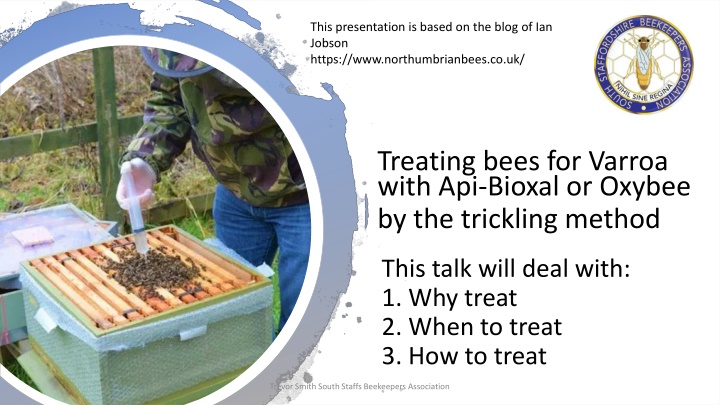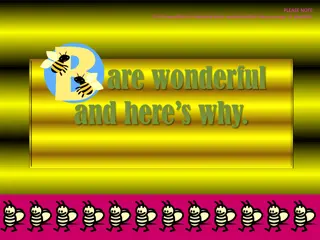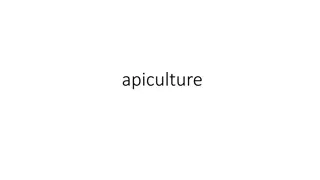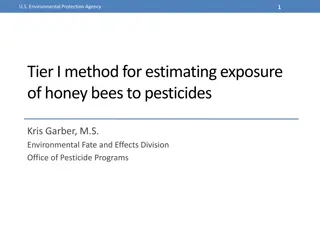Treating Bees for Varroa: Api-Bioxal and Oxybee Methods by Trevor Smith
This presentation, based on Ian Jobson's blog, discusses the treatment of bees for Varroa using Api-Bioxal or Oxybee by the trickling method. It covers why to treat, when to treat, and how to treat, emphasizing the importance of keeping Varroa populations in check to prevent harm to the bees. Trevor Smith from South Staffs Beekeepers Association provides insights on the treatment process, including using Api-Bioxal and the health warnings associated with Oxalic Acid.
Download Presentation

Please find below an Image/Link to download the presentation.
The content on the website is provided AS IS for your information and personal use only. It may not be sold, licensed, or shared on other websites without obtaining consent from the author.If you encounter any issues during the download, it is possible that the publisher has removed the file from their server.
You are allowed to download the files provided on this website for personal or commercial use, subject to the condition that they are used lawfully. All files are the property of their respective owners.
The content on the website is provided AS IS for your information and personal use only. It may not be sold, licensed, or shared on other websites without obtaining consent from the author.
E N D
Presentation Transcript
This presentation is based on the blog of Ian Jobson https://www.northumbrianbees.co.uk/ Treating bees for Varroa with Api-Bioxal or Oxybee by the trickling method This talk will deal with: 1. Why treat 2. When to treat 3. How to treat Trevor Smith South Staffs Beekeepers Association
Why Treat Although there is no clear threshold at which, suddenly Varroa causes harm, it is generally thought that in the UK it is wise to aim to keep the Varroa population below 1000 mites/colony; above this level the risk of damage from the mites, associated pathogens and the effect of feeding on the bees can quickly become very significant. If after a week of monitoring the Varroa drop on my Varroa boards I had a drop of Varroa of 4 or more per day, after a particularly cold spell of weather I would treat with an approved varroacide. Varroa destructor Trevor Smith South Staffs Beekeepers Association
When to Treat in winter Oxalic acid in an approved form of Api-Bioxal requires a brood less period to be effective and so is usually applied very late or very early in the year, after or during a period of cold weather. Research done by Sussex University showed the optimum time to treat using oxalic acid is the beginning of December. During cold weather the queen will go off lay. The majority of the Varroa mites will be on the bodies of the adult bees and are known as phoretic mites. Api-Bioxal will not kill any Varroa mites that are remaining in the capped brood. Trevor Smith South Staffs Beekeepers Association
How to Treat Using Api-Bioxal Api-Bioxal is an approved Oxalic Acid based treatment for varroa. It comes in a 35g sachet. The instructions for making up the syrup are on the back of the packet. The use of pure Oxalic Acid is no longer approved. Trevor Smith South Staffs Beekeepers Association
Health Warning Pure Oxalic Acid is extremely hazardous to us. If you inhale it, ingest it, or even absorb it through the skin, serious internal injuries can result. Including the creation of salts which can crystalise in your kidneys or brain! Before using Api-Bioxal wear the correct PPE of goggles, face mask ( to the correct specification ) and gloves to avoid all direct contact. FFP2 / EN14387 specification Trevor Smith South Staffs Beekeepers Association
Caution Oxalic acid is toxic The lethal dose for humans is reported to be between 15 and 30 g. It causes kidney failure due to precipitation of solid calcium oxalate. Clean up spills of powder or solution immediately. Take care not to inhale the powder. Store in a clearly labelled container out of reach of children. Wear gloves. Do not use containers or utensils you use for food preparation. A carefully rinsed plastic milk bottle, very clearly labelled, is a good way to store the solution prior to use. Trevor Smith South Staffs Beekeepers Association
Why do I prefer trickling to vaporisation? Vaporisation uses the vapour of pure oxalic acid. The solution used for trickling is approximately 4% oxalic acid in a sugar syrup solution. Thus this solution is much less toxic to the beekeeper. There are three key reasons why I prefer the trickling method: It significantly reduces any risk of exposure to pure oxalic acid crystals, dust or vapour. It is simple and quick to do by one person looking after a few hives. The equipment is very portable, readily available and inexpensive. Trevor Smith South Staffs Beekeepers Association
Method Making up the oxalic acid trickling solution is a 2-step process Api-Bioxal is an approved oxalic acid based treatment for varroa. It comes in a 35g sachet. The instructions for making up the syrup are on the back of the packet. Trevor Smith South Staffs Beekeepers Association
Step 1 Ian Jobson s (Northumbrianbees.co.uk) method of making up syrup: 1. 2. 3. Put an empty, clean milk carton on a set of digital scales Zero the scales Add 308g of water into the carton (instructions say 308ml but it s the same thing for pure water at 20 degree C, at sea level!) Zero the scales Add 308g of sugar to the water in the carton 4. 5. . Trevor Smith South Staffs Beekeepers Association
You will now have 500 ml of 50:50 sugar syrup solution. This amount will be enough to treat 10 hives. If you have less colonies, team up with a bee buddy and share the costs. Actually, it s more of a mixture than a solution at the moment, so put the cap on and shake it until the sugar dissolves in the water and allow it to stand. The syrup is stable without the oxalic acid crystals, so you can make up the syrup either on the same day you plan to use it, or well in advance. Trevor Smith South Staffs Beekeepers Association
Step 2 adding the Api-Bioxal to the syrup The Api-Bioxal is best added to the sugar syrup immediately before it is used, at the apiary. The instructions on the packet show that the shelf life of the solution, once the crystals are added to the syrup, it is only 24 hours. This can be done by snipping off the corner of the sachet and pouring it directly into the sugar syrup solution in the carton. This is the only time that you have the possibility of coming into contact with the pure oxalic acid crystals, so use gloves, goggles and a mask and be careful. Make sure to cut just enough off the corner to allow the powder to pour into the carton without any of it escaping down the side or being blown away in the breeze. Safely dispose of the empty sachet, with the little piece you cut off. Trevor Smith South Staffs Beekeepers Association
Preparing to Trickle Lay the carton on its side, with the neck elevated, so that the solution does not flow out. The 60ml syringe is just the right size to go through the neck of the carton. You are now ready to do some trickling! Trevor Smith South Staffs Beekeepers Association
Applying the Api-Bioxal solution by Trickling The instructions for using Api-Bioxal are clear. 5ml of solution should be applied per seam of bees and that a maximum of 50ml of solution should be used for each colony. With a little practice it becomes easy to judge the rate to apply the solution with the syringe. It is more of a controlled dribble than a squirt! I don t feel obliged to use all the 5ml per seam or 50ml per colony. If there are only 6 seams of bees, I ll only trickle these seams and if two of them are only half the width of the frames I ll only use half the amount in those seams. Trevor Smith South Staffs Beekeepers Association
Make sure you take a note of the lot code and expiry date of the Api-Bioxal for your records. You can find out more about the legal requirement to keep records of treatments on the national bee unit website Trevor Smith South Staffs Beekeepers Association
OXYBEE Distributed by the French pharmaceutical company V to-Pharma, Oxybee is a new and easier way to apply oxalic acid during broodless periods to colonies for the treatment of varroa. It is pharmaceutical product licenced by the EU. I have not used this product myself, but I know Dayna has and Thornes bees website has a useful YouTube video on how to make up and use Oxybee. The preparation, use and precautions are all similar to those outlined for Api-Bioxal Trevor Smith South Staffs Beekeepers Association
Using Oxybee Oxybee comes with sachets of powder containing glycerol and essential oils as well as a bottle of oxalic acid. The glycerol increases the adherence of oxalic acid to the bees which improves dissemination throughout the colony. The powder and oxalic acid are mixed together and then applied with a trickle 2 bottle or syringe between the frames occupied by bees. Depending on the strength of the hive and the number of seams of bees in the brood body the litre of Oxybee can treat between 20 and 30 hives. Unlike treatment with Api-Bioxal which has to be used almost immediately after mixing up the solution, one major advantage of Oxybee is that it can be stored for 24 months in the original packaging and 12 months in the fridge once the solution has been made up. There is no withdrawal period which means there is no mandatory waiting time between applying Oxybee and using honey for consumption. Trevor Smith South Staffs Beekeepers Association
Acknowledgements: Ian Jobson www.northumbrianbees.co.uk www.nationalbeeunit.com beebase BBKA News December 2020, page 403 www.thorne.co.uk Trevor Smith South Staffs Beekeepers Association























